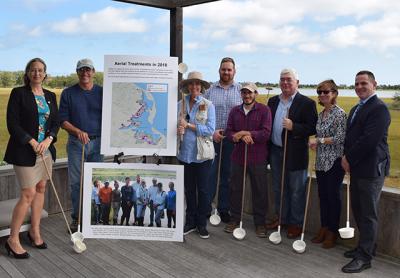Success With Less Spraying

A pilot project that resulted in a dramatic reduction in the aerial application of methoprene, a mosquito larvicide, over the wetlands surrounding Accabonac Harbor last summer was celebrated on Tuesday at the residence of Edwina von Gal, founder of the Perfect Earth Project, in Springs, where government officials including Suffolk County Legislator Bridget Fleming, East Hampton Town Trustees, and the county’s director of vector control gathered.
A joint effort that brought together the county, the trustees, the Nature Conservancy, and the town’s Natural Resources and Planning Departments resulted in targeted application of methoprene — which conservationists fear is harmful to nontarget species including crustaceans — based on weekly mosquito larval sampling and its conveyance to the county’s Department of Public Works, allowing less, and less frequent, application.
With student volunteers, Susan McGraw Keber and John Aldred of the trustees oversaw some 6,000 samples taken over the county’s 11-week spraying season. Samplers sent data to Matt Grasso of the Nature Conservancy, who consolidated the data and forwarded it to the Suffolk Department of Public Works’ vector control division. Tom Iwanejko, the director of vector control, and his staff reviewed the data and issued directives to the county’s helicopter pilots to alter spray patterns based on those data.
Of the 6,000 samples, “only 544 were positive for larvae,” Ms. Fleming said on Tuesday. Importantly, “the larvae were found at the upper edge of the marsh, which meant that a 195-acre spray area that went right to the surface waters was reduced to 95 acres. Right off the bat, we eliminated any spraying near the harbor itself and reduced by over half the area that was treated. Because of this reduction, there was a reduction of 50 percent of the methoprene that was used.”
For four weeks of the 11-week season, no spraying at all took place. The county saved approximately $18,000 thanks to the program.
The volunteers and trustees also discovered physical characteristics of the wetlands, such as a sunken boat that was harboring breeding larvae. The trustees dismantled and removed it, eliminating one breeding “hot spot.”
“When I was first elected in 2015, one of my top priorities was to reduce or eliminate methoprene spraying,” Ms. Fleming said, “not only here but throughout the county. Not only because I see it as a problem because of unintended consequences and secondary impacts on other aspects of the environment, but also because many people pushed me to do that.”
With the sun shining on the harbor behind them, Ms. Fleming and Kevin McDonald of the Nature Conservancy contrasted the cooperative effort to reduce methoprene’s use with a toxic atmosphere in Washington, D.C.
“We are at a time in our country where disagreement so often and so quickly moves toward personal attacks and paralysis,” Ms. Fleming said. “That’s what was happening on the methoprene argument for years: One side said ban it, and the other said public health requires that we eliminate mosquitoes and this is the way to do it, and never the twain should meet. We never got any progress, because the two sides were so entrenched in their silos.”
“It is hard to miss the moment we are in nationally,” Mr. McDonald said, “where everything is a bloodbath over everything.” The pilot program, he said, demonstrated that “a third way to address this issue” was possible.
“I’m saving money at the end of the day,” Mr. Iwanejko said. “I’m happy about that. And we reduced pesticide use. . . . I’m hoping that we could use this project as a springboard . . . to look at restoration of wetlands we don’t need to treat any longer.”
Mosquitoes can carry West Nile virus, Eastern equine encephalitis, and other diseases. As of Friday, 141 mosquitoes and 12 birds collected in Suffolk County this year have tested positive for West Nile virus. Five human cases have been reported, and one horse that tested positive for West Nile died.
Ms. Fleming said that she hoped the program would be replicated in other areas where the county has traditionally sought to control mosquitoes with blanket application of methoprene. “It’s not the end, but it’s a very good start,” she said. “We hope not only to make this program more robust, but to share it with other communities who aren’t necessarily attuned to the dangers of pesticides.”
